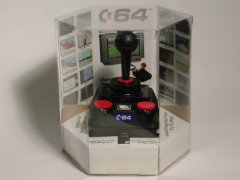C64 - DTV
Introduction
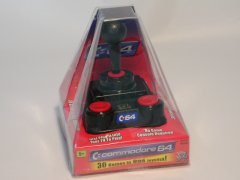 The C64 DTV is a joystick with a complete C64 Commodore inside. And it also contains about 30 games. It can be connected to a TV. The power supply for the DTV are 4 "pen-light" batteries. DTV stands for Direct-to-TV. What means that you can connect the DTV directly to your TV and don't need any extras.
The C64 DTV is a joystick with a complete C64 Commodore inside. And it also contains about 30 games. It can be connected to a TV. The power supply for the DTV are 4 "pen-light" batteries. DTV stands for Direct-to-TV. What means that you can connect the DTV directly to your TV and don't need any extras.On the photo the first version of the C64 DTV. This is a NTSC version. The first generation is packed in a pyramid shape box. The second generation has a hexagonal shape box.
Related links.
Jeri Ellsworth
 The history of the DTV starts with the C-one. The C-one is a computer which is developed by Jeri Ellsworth.
The history of the DTV starts with the C-one. The C-one is a computer which is developed by Jeri Ellsworth.Jeri is a American and born in 1974. Jeri had a passion for electronics from when she was a child. Her father had a special box where everybody could put in old electronics or household appliances. Jeri would take everything apart to find out how it worked. When she took things apart it often was destroyed. But after a lot of experimenting she learned the secrets of electronics. Years later she wanted to experiment with FPGA's (software programmable hardware) and needed a useful project. Because the C64 was always her favorite computer she took on the challenge to improve it.
But what can you improve on the legendary C64. First the VIC-II chip. It could be better Jeri thought. After a lot of programming she had a pretty good proto-type. It was a graphics card for the C64. To understand the C64 better Jeri had a lot of contact with the American Commodore User Groups. After some of the members of the Commodore User Groups saw the graphics card they suggested the idea to improve more on the C64 and to expand it's possibilities. That resulted into the proto-type of the C-one. Together with Individual Computer Jeri developed it to a real product that could be sold. The C-one looks like a ATX motherboard for a PC with connections for: PCI, VGA, parallel port, PC style memory, IDE, PC floppy, Compact Flash and PS2 mouse / keyboard. And extra connections such as: digital joysticks, double SID and a CPU slot. But the nice thing about the C-one is that it has two FPGA's. A FPGA looks a bit like a EPROM but it can do so much more. You can program the FPGA and the FPGA will transform for example in a complete processor. Inside the FPGA's of the C-one there are a CPU, SID, VIC, PLA and all other parts of the real C64. A FPGA can be erased and programmed with a new "program". It is possible to turn the C-one into another computer such as a VIC20, C64 or a CPC computer. The programmer of the C-one can make it's own computer or replicate an existing one inside the C-one.
The C-one did not stay unnoticed by the commercial companies. They wanted a small version of the C-one to sell as a "game-computer". The Companies Tulip (At that time the owner of the brand Commodore), Yeahronimo and Mammoth Toys talked with Jeri to develop a joystick version of the C64. The result was the C64 - DTV. Jeri was not the only person working on this project. Also Jason Compton, Adrian Gonzalez, Robin Harbron, Per Olofsson and Mark Seelye worked on the DTV.
Specifications
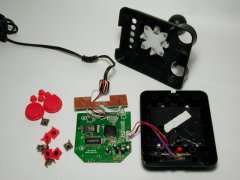 Processor: Atmel ASIC
Processor: Atmel ASICClock-frequency: 32 / 28 MHz (The emulated C64 runs on 1 MHz)
RAM memory: 128 kbyte
ROM memory: 2 Mbyte
Screen: 320 x 200 pix, 40 x 25 chr, 256 clr, 8 mob
Connections: Video, Audio
On the photo the inside of a DTV2. It only has a couple of parts when you compare it to a real C64. And if you keep in mind that it also has a joystick, power supply and a large eprom bank than the size is also nowhere near the original.
The use.

Games:
In contrast to the real C64 the DTV is build only to play games. In the first version of the DTV the following games are available. Bull Riding, Championship Wrestling, Cyberdyne Warrior, Cybernoid, Cybernoid 2, Eliminator, Exolon, Firelord, Flying Disk, Gateway to Apshai, Impossible Mission, Impossible Mission 2, Jumpman jr., Paradroid, Pitstop, Pitstop 2, Ranarama, Silicon Warrior, Speedball, Summer Games, Super Cycle, Sumo, Surfing, Sword of Fargoal, Tower Toppler (Nebulus), Uridium, Winter Games, World Karate Champion A (International Karate 1), World Karate Champion B (International Karate 2) and Zynaps.In the second version of the DTV (DTV2) the following games are available: AlleyKat, California Games, Championship Wrestling, Cyberdyne Warrior, Cybernoid, Cybernoid II, Eliminator, Exolon, Firelord, Gateway to Apshai, Head The Ball, Impossible Mission I, Impossible Mission II, Jumpman Junior, Marauder, Maze Mania, Mission Impossible, Nebulus, Netherworld, Paradriod, Pitstop, Pitstop II, Rana Rama, Speedball, Summer Games, Super Cycle, Sword of Fargoal, Uridium, Winter Games and Zynaps.
All games are fixed to be played with only one joystick and without a "real" keyboard.
Extras:
A number of hidden extras are inside the DTV such as photo of the DTV-team, program information and even a demo.External devices:
The standard DTV has no connections for external devices.Hacking:
Because the DTV is developed by a team of Commodore fans there are some possibilities build in by "accident". it is possible to connect a PC keyboard, 2 external joysticks and a original Commodore serial disk drive to the DTV. It is not just putting in a cable. You will have to modify your DTV (hacking). For hacking see the hacking page on this website.The second generation the DTV2 has a Flash ROM. This makes it possible to alter the programs inside the DTV2 or replace them.
On the photo you can see the DTV in action (the DTV stands on top of the 1571 disk drive). This DTV (version 1) has a external keyboard, two external joysticks and a 1571 disk drive. Upper left corner shows the startup screen of the DTV. Next to that the games menu. In the other picture you can see the DTV booting to BASIC. From the BASIC mode you can load other games such as Boulderdash, Micro-dot and H.E.R.O.
The ASIC.
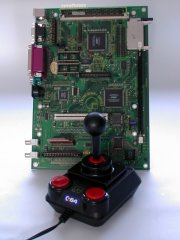 In the introduction it was told that the DTV was derived from the C-one. The C-one has two so called FPGAs. FPGA stands for Field-Programmable Gate Array. This means that a FPGA has logical gates inside like AND, OR, XOR and NOT gates. With these gates you can make almost everything. The only problem is that you will need a lot of the to make for example a processor. But the FPGA's inside the C-one have about 100.000 of these gates. And that is enough to make a complete C64. Another advantage of FPGA's is that you can make all sort of connections between the gates. There are FPGAs that have build in processors and memory.
In the introduction it was told that the DTV was derived from the C-one. The C-one has two so called FPGAs. FPGA stands for Field-Programmable Gate Array. This means that a FPGA has logical gates inside like AND, OR, XOR and NOT gates. With these gates you can make almost everything. The only problem is that you will need a lot of the to make for example a processor. But the FPGA's inside the C-one have about 100.000 of these gates. And that is enough to make a complete C64. Another advantage of FPGA's is that you can make all sort of connections between the gates. There are FPGAs that have build in processors and memory.For the DTV they did not use FPGAs but a ASIC. There are differences between the two. You cannot re-program a ASIC. The ASIC's are faster and cheaper. ASIC stands for Application-Specific Integrated Circuit. What means that it is a speciale designed chip for one purpose only. The program from the FPGAs inside the C-one were translated to a ASIC chip. Simply said that the C-one is now in a ASIC.
In the ASIC of the DTV there are a 6510 CPU, VIC-II, SID, PLA and two CIAs. If you know that the ASIC is about 1 cm2 they you will see that electronics shrunk a lot during the years. This ASIC will do everything that the hardware did inside a real C64. The RAM and ROM memory are not inside the ASIC but are separated chips. They will be described after this.
A big difference is that the clock frequency of the ASIC is much higher than a C64. It's about 32 times faster than a real C64. Does this means that the DTV is faster? Not really. In a real C64 the CPU, VIC-II and the SID work beside each other. The ASIC can only do one task at the time so it will do all the tasks after each other. Switching between the tasks it will have to store data to reload for the next time. Also the serial disk drive is emulated by the DTV to load the games. For these reasons the DTV has to run faster to do all the things that a real C64 does.
The C64 inside the DTV does not run faster but it has some extras. The number of colors is 256 instead of 16. There is also a so called blitter. Amiga fans will know what this is but for the C64 fan this could be something new. A blitter is a routine that could transfer data very fast from one place to another place. You only have to say from which space to where you want to move the data and the blitter will do the rest. But just the way it was with the real C64 there will be found other secrets inside the DTV in the future.
If you want to learn more about the CPU, VIC-II, SID, PLA and the CIA's inside the ASIC then look on the C64 page of this website.
On the picture the DTV with it's "father" the C-one. The son has less possibilities but both will let the legendary C64 life on...
The RAM memory.
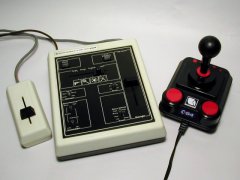 In the DTV there is not 64 Kbytes like in the real C64 but 128 Kbytes of RAM memory. One reason for the larger memory is that the improved possibilities of the VIC-II needs more memory. The extra memory can be used by programmers by switching between the one 64 Kbytes and the other 64 Kbytes. In contrast to the real C64 which had 8 RAM chips of each 8 Kbytes or the C64c with 2 x 32 Kbytes is all of the 128 Kbytes put into one RAM chip.
In the DTV there is not 64 Kbytes like in the real C64 but 128 Kbytes of RAM memory. One reason for the larger memory is that the improved possibilities of the VIC-II needs more memory. The extra memory can be used by programmers by switching between the one 64 Kbytes and the other 64 Kbytes. In contrast to the real C64 which had 8 RAM chips of each 8 Kbytes or the C64c with 2 x 32 Kbytes is all of the 128 Kbytes put into one RAM chip.On the photo another DTV. This is the Commodore 3000H. This model looks a lot like the DTV. It has only one chip that does everything like the CPU, screen and sound. It has different build in games. But the games are nothing compared to the DTV. There is about 25 years age difference between them.
The ROM memory.
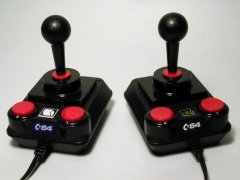 In the DTV there is not 20 Kbytes ROM like in the real C64 but 2 Mbytes of ROM memory. In the DTV1 there is a real ROM that cannot be changed but in the DTV2 there is a Flash ROM which can be changed.
In the DTV there is not 20 Kbytes ROM like in the real C64 but 2 Mbytes of ROM memory. In the DTV1 there is a real ROM that cannot be changed but in the DTV2 there is a Flash ROM which can be changed.In the ROM there are the same ROM's as in the real C64 such as the kernel, BASIC and the characters. In the DTV there also the 30 games inside this ROM chip. Also the boot screens and the game menu. And some Easter eggs from the developer team.
The advantage of having the games inside the ROM is that it will take only a fraction of time to load the games compared to a serial disk drive.
There are people who re- Flashed the ROM of the DTV2. They can change the programs or completely remove or replace them.
On the photo the DTV2 in its hexagonal packaging. Main difference between the DTV and the DTV2 is that the DTV2 can do PAL and NTSC by replacing some parts on the PCB. The DTV2 has a Flash ROM.
The connections.
 The standard DTV has only a few connections. There is the Video connection which will display the screen on a TV or a Video monitor. And it has a Audio connection for the sound. In the bottom of the DTV there is room for four batteries that supply the power to the DTV.
The standard DTV has only a few connections. There is the Video connection which will display the screen on a TV or a Video monitor. And it has a Audio connection for the sound. In the bottom of the DTV there is room for four batteries that supply the power to the DTV.It is possible to make extra connections on the PCB of the DTV. These connection are a PC keyboard, serial disk drive and two digital joysticks. On the DTV is the second joystick not totally available. It lacks the UP. But this can be done by hacking the keyboard. More on expanding your DTV can be read on the Hacking page on this website.
The original housing of the DTV does not have much room for the extra connectors. Many hackers build the DTV PCB into a new housing or connected the DTV to a disk drive where they installed the connectors.
On the photo a hacked DTV2 with a expansion-box. In this expansion-box there are connectors for a external keyboard, serial IEC connection and two joysticks. There is also a IEC reset switch to reset the disk drive. The expansion-box is connected via a flat-cable to the DTV.
Update: 2019-05-11 13:12:48
